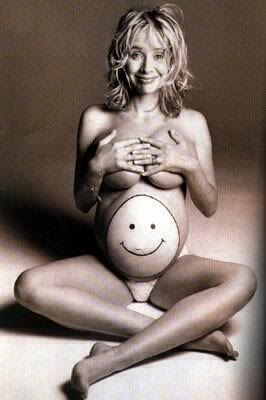from the New York Observer
What Makes Annie Shoot?
The great Leibovitz realized she was never a journalist but made news with magazine covers. An artist who was once fascinated with her subjects lately seems largely fascinated with herself BY CHOIRE SICHA
“I look back at it now,” Annie Leibovitz said at the Rochester Institute of Technology in 1991, “I realize that one of the things I loved toward the end at Rolling Stone were the conceptual covers.” She had left for Vanity Fair in 1983, in part to follow an art director she admired. There she did little until Tina Brown arrived all bluster and balls in 1984—and then she did a lot.
 Jann Wenner, Rolling Stone’s owner-operator, had become overly concerned about newsstand sales. “He wanted really clean, you know, head shots really. There was a study—they started to do studies, you know,” Ms. Leibovitz said. “And they came up with this study that the conceptual covers didn’t sell well because the person wasn’t recognizable. … For example, the Steve Martin photograph against the Franz Kline painting was the worst-selling cover that year.”
Jann Wenner, Rolling Stone’s owner-operator, had become overly concerned about newsstand sales. “He wanted really clean, you know, head shots really. There was a study—they started to do studies, you know,” Ms. Leibovitz said. “And they came up with this study that the conceptual covers didn’t sell well because the person wasn’t recognizable. … For example, the Steve Martin photograph against the Franz Kline painting was the worst-selling cover that year.”
Annie Leibovitz had gotten too rock ’n’ roll forRolling Stone.
That worst-selling cover—from February 1982—is a real mess, in today’s focus-group-in-a-Chicago-mall terms. Mr. Martin, in a suit, is painted with crude black stripes, and is in mid-campy-dance-step. The black-and-white painting looms beyond him. (Inside you might have learned that he would prefer not to discuss his relationship with Bernadette Peters.)
Then there was her Matt Dillon cover late that year. Mr. Dillon, pouty and incredibly young, is in slacks and shirt and tie, twisted and reclining, one leg up, thereby showing half his ass—and with his crotch placed nearly dead center on the magazine’s cover. What definitely seems to be Mr. Dillon’s extended middle finger rests near his square hairline. It was her last Rolling Stone cover. Now that’s how you say goodbye—to your magazine, your youth, whatever.
Ms. Leibovitz was, for much of the 80’s, an unusual bridge between the fine art world and the commercial world. This meant that in her practice she gathered commerce in one hand and journalism in the other.
Then as magazines went, so went Annie Leibovitz.
